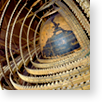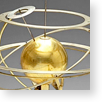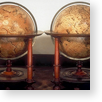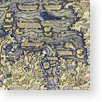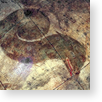A singular form of assimilation and updating of Ptolemy's Geography, one of the founding texts of modern geographical studies, was the ambitious project for the Guardaroba Nuova in Palazzo Vecchio, conceived by Cosimo de' Medici as a grandiose theatrum mundi. This project was then emulated by Ferdinando I in the Uffizi Gallery, with a Cosmographic Room containing representations of the Medicean domains and a great Ptolemaic model of the universe designed by the cosmographer Antonio Santucci. It is the great armillary sphere that dominates this room, surrounded by terretrial and celestial globes of the finest workmanship.
In the adjacent room are four globes by the Venetian cosmographer Vincenzo Maria Coronelli. Famous for the great size of his creations, he built enormous globes, nearly four meters in diameter, for Louis XIV, King of France,.
As Coronelli explained in his Epitome cosmografica published in 1693, these globes are formed of many hand-written or printed sheets of paper, called gores, glued onto a large ball made of wood and papier-mâché coated with plaster.
Antonio Santucci's Armillary Sphere
Reader in Mathematics at the University of Pisa, 1599-1612, Antonio Santucci was an astronomer and cosmographer to Grand Duke Ferdinand I (1549-1609) and ...
(3 objects)
Models of the Heavens
Since antiquity, astronomers have studied the movement of the stars, striving to reproduce the appearance of the heavens by means of suitable models. One ...
(8 objects)
Terrestrial and Celestial Globes
The humanists' interest in Ptolemy's Geography and the discovery of the New World favoured the rapid development of modern cartography thanks to the large ...
(24 objects)
The world map of Fra' Mauro
Fra' Mauro, a Camaldolese monk, was active in Venice toward the mid-fifteenth century. His world map depicts the image of the Earth prevailing before the ...
(1 objects)
Vincenzo Coronelli’s Globes
Six globes made by the Venetian cosmographer Vincenzo Maria Coronelli (1650-1718), famous for the great size of his creations, such as the globes nearly ...










